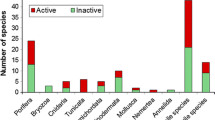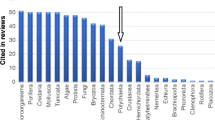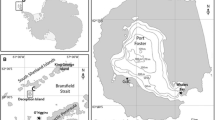Abstract
The gorgonian octocoralLeptogorgia virgulata (Phylum Coelenterata, Class Anthozoa) is rarely overgrown by fouling organisms and is avoided by most predators. Laboratory experiments suggest that secondary metabolites and calcium carbonate spicules interact synergistically to provideL. virgulata with an effective defense against predatory fish. In spite of these defenses,L. virgulata is consumed by the symbiotic, trophically specialized gastropodNeosimnia uniplicata, which closely mimics the appearance of the gorgonian.Neosimnia uniplicata is readily eaten by fish and appears not to acquire an effective antipredator defense from its gorgonian host. Extracts ofLeptogorgia virgulata andNeosimnia uniplicata strongly inhibited the settlement of the barnacleBalanus atnphitrite. Bioassay-directed purification of the more potent antifouling agents fromL. virgulata led to the isolation of two previously described, diterpenoid hydrocarbons, known as pukalide and epoxypukalide. A third inhibitor of barnacle settlement, whose structure is presently unknown, was obtained from bothL. virgulata andN. uniplicata. When assayed for ability to inhibit barnacle settlement, these three compounds possessed EC50 values ranging from 19 to 55 ng/ml. These secondary metabolites may prevent the overgrowth ofL. virgulata by fouling organisms in nature. The allelochemicals ofL. virgulata, N. uniplicata, and other marine organisms may provide nonpolluting alternatives to existing, commercial antifoulants based on derivatives of tri-n-butyltin.
Similar content being viewed by others
References
Bakus, G.J. 1981. Chemical defense mechanisms and fish feeding behavior on the Great Barrier Reef, Australia.Science 211:497–499.
Bakus, G.J., Targett, N.M., andSchulte, B. 1986. Chemical ecology of marine organisms: An overview.J. Chem. Ecol. 12:951–987.
Bayer, F.M. 1961. The Shallow-Water Octocorallia of the West Indian Region. Studies on the Fauna of Curacao and other Caribbean Islands, No. 55. Martinus Nijhoff, The Hague.
Bergquist, P.R. 1978. Sponges. Hutchinson and Company, London.
Burkholder, P.R. 1973. The ecology of marine antibiotics and coral reefs, pp. 117–203,in O.A. Jones and R. Endean (eds.). Biology and Geology of Coral Reefs, Vol. II. Biology I. Academic Press, New York.
Ciereszko, L.S. 1962. Chemistry of coelenterates. III. Occurrence of antimicrobial terpenoid compounds in zooxanthellae of alcyonarians.Trans. N. Y. Acad. Sci. 00:917–919.
Cimino, G. andDestefano, S. 1978. Chemistry of Mediterranean gorgonians: simple indole derivatives fromParamuricea chamaeleon.Comp. Biochem. Physiol. 61:361–362.
Coll, J.C., andSammarco, P.W. 1983. Terpenoid toxins of soft corals (Cnidaria, Octocorallia): Their nature, toxicity, and ecological significance.Toxicon (Suppl.) 3:69–72.
Coll, J.C., Tapiolas, L.M., Bowden, B.F., Webb, L., andMarsh, H. 1983. Transformation of soft coral (Coelenterata, Octocorallia) terpenes byOvula ovum (Mollusca, Prosobranchia).Mar. Biol. 74(1):35–40.
Colwell, R.R. 1983. Biotechnology in the marine sciences.Science 222:19–24.
Costlow, J.D., andTipper, R.C. (eds.) 1984. Marine Biodeterioration: An Interdisciplinary Study. Naval Institute Press, Annapolis, Maryland. 384 pp.
Faulkner, D.J. 1977. Interesting aspects of marine natural products chemistry.Tetrahedron 33:1421–1443.
Faulkner, D.J. 1984. Marine natural products: Metabolites of marine invertebrates.Nat. Prod. Rep. 1:551–598.
Faulkner, D.J., andGhiselin, M.T. 1983. Chemical defense and evolutionary ecology of dorid nudibranchs and some other opisthobranch gastropods.Mar. Ecol. Prog. Ser. 13:295–301.
Fenical, W. 1982. Natural products chemistry in the marine environment.Science 215:923–928.
Fenical, W., Okuda, R.K., Bandurraoa, M.M., Culver, P., andJacobs, R.S. 1981. Lophotoxin: A novel neuromuscular toxin from Pacific sea whips of the genusLophogorgia.Science 212:1512–1513.
Gerhart, D.J. 1984. Prostaglandin A2: An agent of chemical defense in the Caribbean gorgonianPlexaura homomalla.Mar. Ecol. Prog. Ser. 19:181–187.
Gerhart, D.J. 1985. Chemical ecology on the coral reef: Prostaglandins in the gorgonianPlexaura homomalla.Proc. Fifth Int. Coral Reef Congress 6:57–62.
Gerhart, D.J. 1986. Prostaglandin A2 in the Caribbean gorgonianPlexaura homomalla: Evidence against allelopathic and antifouling roles.Biochem. Syst. Ecol. 14:417–421.
Goad, L.J. 1978. The sterols of marine invertebrates: Composition, biosynthesis, and metabolism, pp. 76–172,in P.J. Scheuer (ed.). Marine Natural Products: Chemical and Biological Perspectives, Vol. 2. Academic Press, New York.
Hadfield, M.G., andCiereszko, L.S. 1978. Action of cembranolides derived from octocorals on larvae of the nudibranchPhestilla sibogae, pp. 145–150,in P.N. Kaul and C.J. Sinderman (eds.). Drugs and Food from the Sea: Myth or Reality? University of Oklahoma, Norman.
Harvell, C.D., andSuchanek, T.H. 1987. Partial predation on tropical gorgonians byCyphoma gibbosum (Gastropoda).Mar. Ecol. Prog. Ser. 38:37–44.
Keifer, P.A., Rinehart, K.L., andHooper, I.R. 1986. Renillafoulins, antifouling diterpenes from the sea pansyRenilla reniformis (Octocorallia).J. Org. Chem. 51:4450–4454.
Kinzie, R.A. 1974.Plexaura homomalla: The biology of a harvestable marine resource, pp. 22–38,in F.M. Bayer and A.J. Weinheimer (eds.). Prostaglandins fromPlexaura homomalla: Biology, Utilization and Ecology of a Major Medical Marine Resource. University of Miami, Miami.
Legendre, L., andLegendre, P. 1983.Numerical Ecology. Elsevier Scientific, Amsterdam. 419 pp.
Lieberman, H.R. 1983. Estimating EC50 using the probit technique: A basic computer program.Drug Chem. Toxicol. 6:111–116.
Littler, M.M., Littler, D.S., andTaylor, P.R. 1987. Animal-plant defense associations: Effects on the distribution and abundance of tropical reef macrophytes.J. Exp. Mar. Biol. Ecol. 105:107–122.
Missakian, M.G., Burreson, B.J., andScheuer, P.J. 1975. Pukalide, a furanocembranolide from the soft coralSinularia abupta.Tetrahedron 31:2513–2515.
Osborn, H.L. 1885. Mimicry in marine Mollusca.Science 6:9–10.
Paine, R.T. 1963. Food recognition and predation on opisthobranchs byNavanax inermis.Veliger 6:1–9.
Patton, W.K. 1972. Studies on the animal symbionts of the gorgonian coral,Leptogorgia virgulata (Lamarck).Bull. Mar. Sci. 22:419–431.
Rittschof, D., andBonaventura, J. 1986. Macromolecular cues in marine systems.J. Chem. Ecol. 12:1013–1023.
Rittschof, D., Branscomb, E.S., andCostlow, J.D. 1984. Settlement and behavior in relation to flow and surface in larval barnacles,Balanus amphitrite Darwin.J. Exp. Mar. Biol. Ecol. 82:131–146.
Rittschof, D., Hooper, I.R., Branscomb, E.S., andCostlow, J.D. 1985. Inhibition of barnacle settlement and behavior by natural products from whip corals,Leptogorgia virgulata (Lamarck, 1815).J. Chem. Ecol. 11:551–563.
Rittschof, D., Hooper, I.R., andCostlow, J.D. 1986. Barnacle settlement inhibitors from sea pansies,Renilla reniformis.Bull. Mar. Sci. 39:376–382.
Robertson, R. 1970. Review of the predators and parasites of stony corals, with special reference to symbiotic prosobranch gastropods.Pac. Sci. 24:43–54.
Scheuer, P.J. (ed.) 1985. The organic chemistry of marine products. Symposia in Print No. 18.Tetrahedron 41:979–1118.
Silveira, F.L. Da, andVan'thof, T. 1977. Regeneration in the gorgonianPlexaura flexuosa (Cnidaria, Octocorallia).Bijdr. Dierkd. 47:98–108.
Sokal, R.R., andRohlf, F.J. 1983. Biometry. Freeman, San Francisco.
Standing, J., Hooper, I.R., andCostlow, J.D. 1982. Inhibition and induction of barnacle settlement by natural products present in octocorals.J. Chem. Ecol. 10:823–834.
Stoecker, D. 1978. Resistance of a tunicate to fouling.Biol. Bull. 155:615–626.
Stoecker, D. 1980. Chemical defenses of ascidians against predators.Ecology 61:1327–1334.
Targett, N.M., Bishop, S.S., McConnell, O.J., andYoder, J.A. 1983. Antifouling agents against the benthic marine diatomNavicula salinicola: Homarine from the gorgonianLeptogorgia virgulata andL. setacea and analogs.J. Chem. Ecol. 9:817–829.
Thompson, T.E. 1976. Biology of Opisthobranch Molluscs, Vol. I. The Ray Society, London.
Thompson, T.E., andBrown, G.H. 1984. Biology of Opisthobranch Molluscs, Vol. II. The Ray Society, London.
Tursch, B. Braekman, J.C., Daloze, D., andKaisin, M. 1978. Terpenoids from coelenterates, pp. 247–296,in P.J. Scheuer (ed.). Marine Natural Products: Chemical and Biochemical Perspectives, Vol. 2. Academic Press, New York.
Author information
Authors and Affiliations
Rights and permissions
About this article
Cite this article
Gerhart, D.J., Rittschof, D. & Mayo, S.W. Chemical ecology and the search for marine antifoulants. J Chem Ecol 14, 1905–1917 (1988). https://doi.org/10.1007/BF01013485
Received:
Accepted:
Issue Date:
DOI: https://doi.org/10.1007/BF01013485




